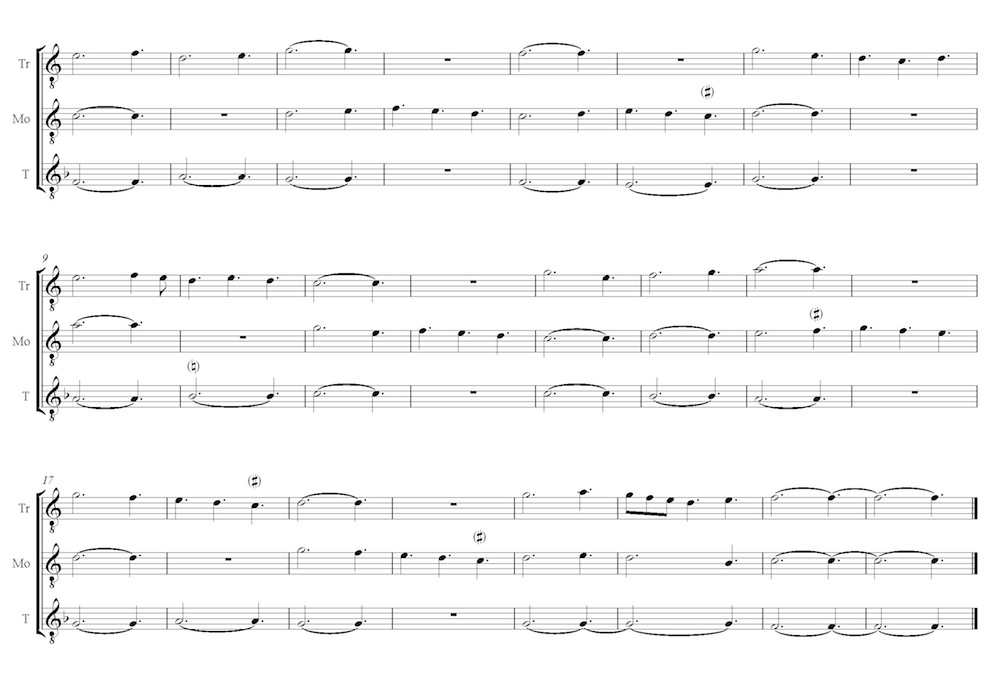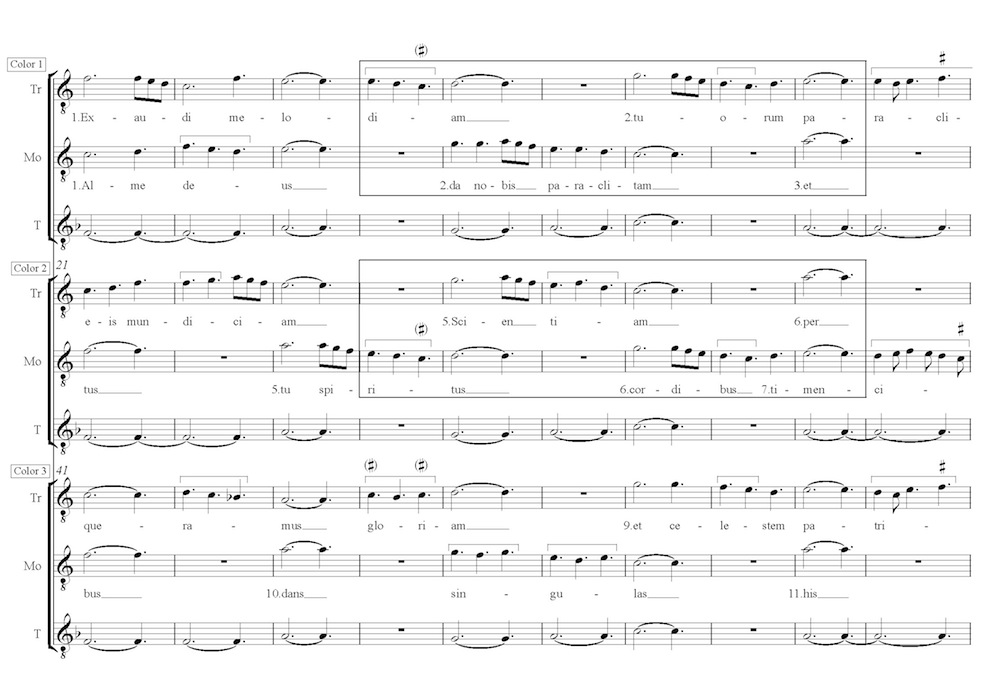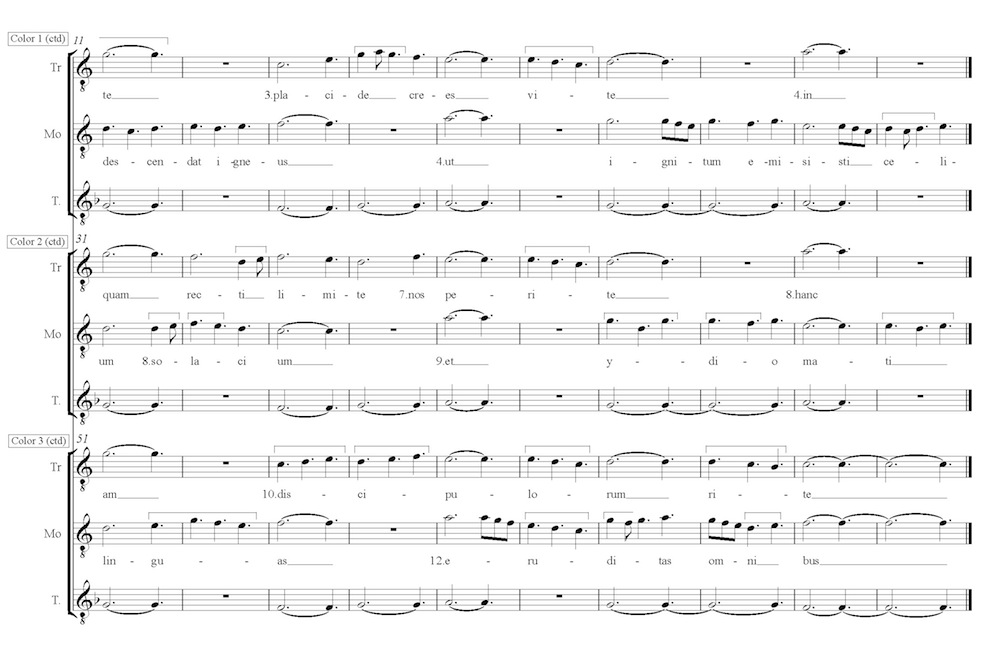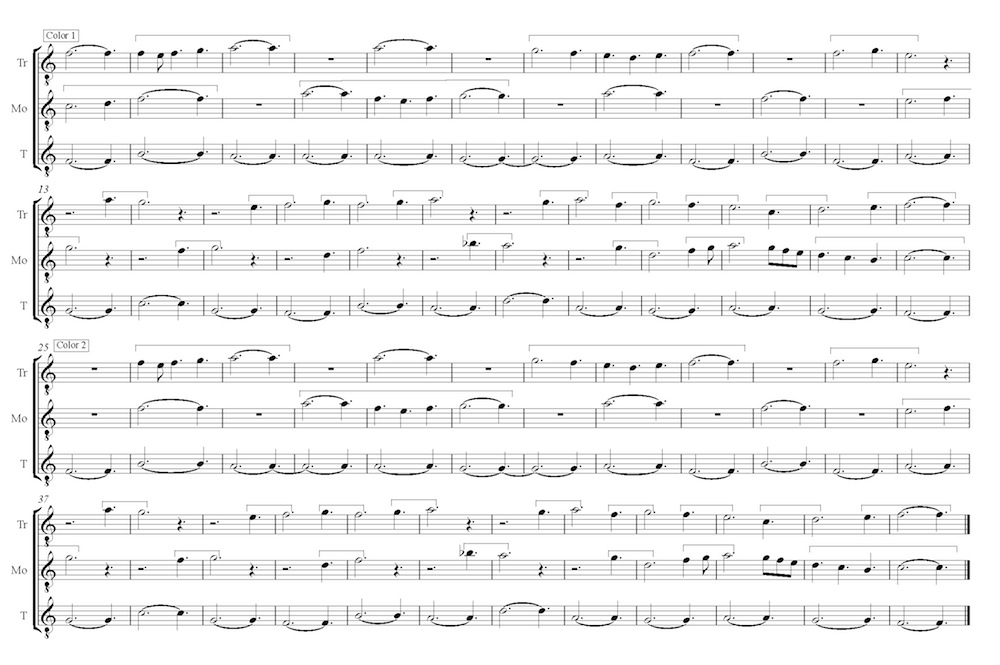
In 1970, Jürg Stenzl published an account of an unusual polyphonic motet copied in a manuscript of chant from a the Abbey of Saint-Maurice in the Valais, Switzerland, together with a transcription of the motet and images of the manuscript. The manuscript, Saint-Maurice MS 4, is a notated gradual of unknown provenance, which has been in the abbey since before 1920.[1] Stenzl noted that the feasts in the gradual suggest that the book as a whole came from Franciscan circles and is not originally from the Valais.[2] On f.123v, a blank page at the end of the Temporale, a hand that Stenzl diagnoses as being a little later than the main hand has added what Stenzl neologizes as a ‘Sanctus Motet’, whose two upper voices, notated in the mensural notation of the ars nova, in tempus perfectum with major prolation, both have texts starting with a triple ‘Sanctus’ invocation and then proceed respectively ‘Exaudi melodiam’ (Triplum) and ‘Alme deus’ (Motetus); the tenor designation is not given.
Certain aspects of the notation led Stenzl to the conclusion that the Saint-Maurice source (hereafter StM) had been ‘translated’ from an earlier notational format, specifically that kind of notation typified by the motets in the seventh and eighth fascicles of the Montpellier motet manuscript (F-MO 196). All three voices of the motet in StM notate perfect breves in the form of a long, whereas imperfect breves have their normal form and perfect breve rests following line ends are also correctly written (a line through one space). The tenor notation, for example, has groups of three longs which are to be read as perfect breves, each group separated by a correctly written perfect breve rest.[3]
Stenzl’s hunch was correct. Since he wrote his article another copy of this motet has come to light, in a fragment now in Dijon, which is indeed in an earlier notational style. And the Dijon version (hereafter Dij) shows that his diagnosis about the notation was not his only correct surmise on the basis of the single copy of the motet he had in front of him. Given that the motet texts make no further reference to the Sanctus after the initial section’s identical triple invocation in the upper voices of the StM version, Stenzl considered the initial reference to the Sanctus a later textual addition to an initial melisma.[4] In the Dij notation, there is indeed no text for this initial section, which is presented as a textless melisma.
Dij forms the flyleaf to a book, F-Dm 35, from the first half of the thirteenth century, which contains the Gospels, Canticum canticorum, and Glossa ordinaria. The book itself has been at Cîteaux since the thirteenth century, although its binding dates from the fifteenth century, according to Barbara Haggh’s 2002 description.[5] Given that the flyleaf dates from the early fourteenth century, that is, after the date of the contents of the book that it serves, it was probably added at the time of binding, by which time the fourteenth-century music (but not the contents of the thirteenth-century book) had fallen out of use. The flyleaf will be viewable on DIAMM via this specific page once the library grants permissions.
Haggh classes the motet among those she discusses as ‘previously unknown’, and her brief description does not therefore note the concordance in StM.[6] This omission leads her to diagnose the untexted melisma at the top of each of the upper voice columns as the tenor of a different, preceding motet. (This is the section text with triple ‘Sanctus’ invocations in both voices in StM.) Comparison with StM provides a shortcut to seeing these untexted lines instead as the opening part of this motet, despite their textless status in the Dijon leaf, and they fit perfectly with the opening of the motet’s tenor part.
Following the motet, the flyleaf also contains the tenor Hec dies, noted by Haggh as identical to the chant tenor used in several thirteenth-century motets.[7] Although she notes that it extends ‘on four staves written across the bottom of the page’, this is not completely accurate. These four staves are written on two lines with a central division, as if they were originally designed for parallel (equal) upper voices of a new motet. If this were the plan, it was clearly abandoned in favour of copying not one but two motet tenors, each entered on a single line of the left hand column, leaving both right hand stave lines blank. The Haec dies tenor is only the first of these two staves. The second staff (the bottom-most line of the page as it survives) might originally have had a textual identification that is now cut away, but from the pitches given it appears to be another tenor found in thirteenth-century motets, its pitches taken from an ‘Alleluya’, and in roughly the same rhythm as that found in the short refrain motet in Montpellier, Endurez, endurez / ALLELUIA (Mo248). The music hand for both these motet tenors looks similar to that for the rest of the leaf, but the hand for the only visible text (‘Hec dies’) is a less careful one, perhaps that of the music scribe who chose to enter some additional music in space left after the text scribe had already finished work.[8]
| Triplum | Motetus | ||||||
|---|---|---|---|---|---|---|---|
| 1. | Exaudi melodiam | 7pp | a | 1. | Alme deus, | 4p | a |
| 2. | tuorum, paraclite; | 7pp | b | 2. | da nobis paraclitum, | 7pp | b |
| 3. | placide crees vite | 7p | b | 3. | et descendat igneus | 7pp | a |
| 4. | in eis mundiciam, | 7pp | a | 4. | ut ignitum | 4p | b |
| 5. | scientiam | 4pp | a | ||||
| 5. | emisisti celitus | 7pp | c | ||||
| 6. | per quam recto limite | 7pp | b | 6. | tu spiritus | 4pp | c |
| 7. | nos perite | 4p | b | 7. | cordibus timencium | 7pp | d |
| 8. | hanc queramus gloriam | 7pp | a | 8. | solacium | 4pp | d |
| 9. | et celestem patriam | 7pp | a | ||||
| 10. | discipulorum rite. | 7p | b | 9. | et ydiomatibus | 7pp | e |
| 10. | dans singulas | 4pp | f | ||||
| 11. | hiis linguas | 4p | f | ||||
| 12. | eruditas omnibus. | 7pp | e | ||||
| Hear the melody of thy servants, O Paraclete (Comforter), create in them the cleanliness of a peaceful life, the knowledge through which, by a straight path, we may skilfully seek this glory and our heavenly fatherland in the manner of disciples. | Nurturing God, give us thy Comforter and let him come down on fire as thou didst send him down fiery from heaven, O Spirit, to the hearts of the fearful a solace… | ||||||
| 6. StM recti | 2. paraclitam; ending cut away in Dij | ||||||
The two texts of the motet are given in Figure 1.[9]
The ten-line triplum is fairly regular and can be understood as two stanzas of five lines of which the rhyme scheme of the second is an inverted palindrome of the first: i.e. the lines of the second stanza both reverse the pattern of the first and have the other kind of rhyme in each case, with a-rhymes as b-rhymes and vice versa (overall, abbaa bbaab). The two rhymes used are the same in each stanza. The triplum text references its status as a sung imprecation as it asks the Paraclete to ‘hear the melody of Thy servants’ and make them good enough in this life to be as disciples in the heavenly fatherland.
The motetus text is made up of three stanzas, each of four lines and also shows a complex but regular concern for patterns of rhyme. Each stanza here has different rhymes and a different pattern. The first stanza interlaces (abab), the second has couplets (ccdd), and the third has a palindromic rhyme scheme (effe). The text here is less grammatically assured, but asks God to send his Spirit down so that, as in Acts 2:6, each may hear the other speak in his own language.[10]
Although the texts are in Latin, stress is ignored, with the triplum’s ‘vite’ (paroxytonic, i.e. p) happily rhyming with ‘paraclite’ (proparoxytonic, i.e. pp), and the motetus’s ‘deus’ (p) rhyming with ‘spiritus’ (pp). Instead, the poetry works by syllable count (in the triplum 7-syllable lines, except lines 5 and 7, which have 4 syllables; in the motetus with a regular patterning of 4 and 7-syllable lines in each stanza). This strongly suggests a poet more familiar with the norms of Romance poetry, probably a speaker of some variety of French.
The tenor of the motet is not identified as a chant fragment and can be understood as being in three sections, corresponding to the three sections of the motet, separated by marked section breaks in both sources and here labelled sections A, B, and C.[11] All three of the tenor sections present melodies based on the pitch F, and mainly occupying the fifth up to c, although rising to d in section C. Figures 2A, 2B, and 2C gives editions of these sections.




The Dijon copy is cut away on the right hand side, which means that parts of the motetus and tenor are missing. Nonetheless, the surviving music shows few variants excepting the greater use of ligatures in this notational style, which clarifies the texting of the upper voices. The variants and small number of errors are listed in the Appendix below.
Thus far, Stenzl’s perceptions about the motet’s notation and texting have largely been confirmed by the discovery of a concordance. His further conclusions about the place of the motet in music history, however, are more questionable, if only because they rest on the assumptions of much older scholarship in which the imprint of a nationally (or at least patriotically) driven music history is clearly perceptible. Stenzl’s correct claim about the irregular use of long forms for perfect breves in StM betraying the translation of an earlier notational style into ars nova notation is accompanied with the thought that the notator of this version was perhaps located somewhere ‘peripheral’, because he hadn’t quite mastered the art of ars nova notation.[13] While Stenzl might mean that this particular notator was working somewhere less geographically central, his claim folds easily into the material in the second part of the article, which argues that the motet itself is from such a periphery, specifically from England, on the basis of features that it shares with other motets that had, at that time, been identified as English. Stenzl’s point of departure is Besseler’s 1927 identification of certain pieces in which he claimed the motet and conductus styles had become so enmeshed that it was possible to view them as leading towards the ars nova.[14] Besseler’s list, as repeated and expanded by Stenzl, consists of eight motets from the last two fascicles of Montpellier. In listing them again here, I not only summarize the features that Stenzl draws out from them as indicative of Exaudi melodiam/Alme Deus’s place in this group, but also signal my doubts about the tightness of the grouping by offering thoughts on how unalike some of these features really are.
As he goes through this list, Stenzl notes earlier discussions of this group, notably that by Handschin, who is mentioned as considering all of the six motets on Besseler’s original list as likely to be English.[19] Stenzl’s conclusion is that, given the company it keeps, his ‘Sanctus motet’ seems rather likely to be English. He notes furthermore that it seems to conform to several of Apfel’s ‘traits of Englishness’, namely no.20 (lack of tenor identification), no.22 (change of tenor cants firmus in the repeat, i.e. Paraphrase), no.51 (melodic repeat in the upper voices), no.52 (rhythmic imitation), no.53 (melodic imitation), no.56b (isoperiodism), but also cautions that the question must remain open.[20]
There are many things to question here. As will be clear from my brief comments on the list above, I am not convinced that all of the motets have more than a few elements in common and wouldn’t like to offer them as a strongly defined group given their mutual differences. Stenzl does set aside Mo339 and stresses that the question of origin remains open, but his case for associating these piece and their Englishness is nonetheless made, and no alternative interpretation is offered. For me the listing of features focuses too much on the structural and textural and not enough on the performed effect of the pieces, their texting, and their likely meanings; there are certainly some points of comparison and similarity, but the whole set of issues seems to need revisiting.
Stenzl was writing in 1970, when there was less self-conscious reflection on music-historical method and when the recent turn toward the need for an understanding historiographical details in order to strip away certain kinds of ‘master narrative’ from music history had not yet occurred. From a perspective in 2011, I find it surprising that motets can be considered ‘English’: most of them appear uniquely in a Parisian source (Montpellier); Mo275 is widely copied in Europe; and Mo275 and Mo340 and Mo341 appear in a fragment now in Oxford whose Englishness is asserted by RISM with no grounds given.[21] I’m not sure what ‘English’ means in itself, nor what implication it might have for how we are to understand these pieces of music. Are these motets ‘by’ English composers, or were they merely sung in England, or were they sung by English singers? And what does ‘English’ signify when a piece is clearly being transmitted in mainland Europe, sung by singers who are from various parts of Europe, and in a period before the establishment of the modern nation state? The identity of ‘Englishness’–given the government of the non-continental part of England by members of the French royal house and the presence of large parts of ‘England’ (if we call England that which is governed by the English King) on the continental mainland of what is now France–seems rather hard to define.
Stenzl’s dating of the motet, too, relies on assumptions that now might be open to historiographically motivated question. The motet’s closeness to the motets in the last two fascicles of Montpellier in terms of its notational style and its musical style (as posited in its membership of the group outlined above) might place it around 1300 (depending on the notoriously problematic dating of the last two fascicles of Montpellier). Stenzl claims, too, that Exaudi melodiam/Alme Deus is similar to the motets in the interpolated version of Fauvel, (which dates from the late thirteen-teens but whose pieces, especially the motets, draw on a repertoire from a little time before that date). Judging by its texts, the motet can be assumed to have had a liturgical use, but Stenzl, quoting Besseler, affirms that the group within which Exaudi melodiam/Alme Deus seems to belong marks it as a representative of a new kind of motet, which extended the old tradition of liturgical music so as to introduce a newer, more audience-focused ‘artwork’, paving the way for the individuality of the motets of Philippe de Vitry and the subtilitates artium.[22] Again, the notational and stylistic teleology on which this conclusion depends dates back at least to the early twentieth century and now needs revisiting.
Several research questions arise from reviewing Stenzl’s article in the light of the identification of the same motet in the Dijon fragments. Stenzl’s focus was on then-traditional questions of date and provenance, although it is unclear whether he considers the latter to be defined by the geographical place where the composer composed the piece or the national origins of the composer; what is clear is the emphasis on a composer rather than the diffusion of the motet as a performative item, meaningful to singers and listeners. The relatively high textual stability of the ‘work’ between the two surviving copies might point to assumptions about the motet’s ‘composerliness’ as a reasonable starting point, but consideration of the reception of this piece would nevertheless aid any understanding of its place in music history.
One might now ask questions about the wider diffusion and use of this motet. The Dijon fragment seems to emanate from Cîteaux so can’t readily be associated with the Franciscan practice of the StM book. The other music in the leaves from Cîteaux that feature in Haggh’s article are of a similar date and have been shown to have concordances with hockets quoted in a thirteenth-century theory source.[23] Perhaps this motet, too, can be associated with the thirteenth-century growth of Cistercian foundations in Europe.
In terms of date, the Dijon manuscript clearly shows an earlier notational style, but this doesn’t necessarily mean that it transmits an earlier copy of the piece; assessing that would rely on dating the fragmentary leaves themselves. The easy teleological progress of both notational and musical styles seems difficult to rely upon, as questionable in its older musicological values as the easy positing of centre and periphery. A more nuanced music-analytical study of motets might go some way to refining the grouping provided by Besseler and Stenzl, especially if its taxonomy were to rely less on listable structural features of pitch and rhythm and more clearly on the kind of integrated musico-textual analyses of motets that have recently begun to appear.[24] Certainly much work remains to be done in a newer musicological climate with an emphasis on singers, receiving communities, use, and meaning.
Triplum StM no ligatures; triple ‘Sanctus’ invocations starting in bars 1, 9.2, 17.
Motetus StM no ligatures; triple ‘Sanctus’ invocations starting in bars 1, 9, 19. bb.22–4: Dij missing (cut away)
Tenor bb. 21–2: StM 2 notes
Triplum b.4: StM no lig b.10–11: StM no lig b.14: StM no lig b.16: StM no lig b.22: StM no lig b.26: StM no lig b.32: StM no lig b.36: StM no lig b.41: StM no flat b.42: StM no lig b.44: StM lig only for notes 1–2 b.50: StM lig only for notes 3–4 b.53: StM lig only for notes 1–2 b.54: StM lig only for notes 1–2 b.56: StM lig only for notes 1–2 b.58: StM lig only for notes 1–2
Motetus b.2: StM no lig bb. 7–8: Dij missing (cut away) b.17: StM g-d-g [as in color 2] b.18: StM lig 1–2 bb. 18.1–2: Dij missing (cut away) b.20: StM d-e b.24: StM lig only for notes 1–2 bb. 28.3–29: Dij missing (cut away) b.31: StM no lig b.37: StM lig only for notes 1–2 b.37.2: StM e b.40: StM lig only for notes 1–2 bb. 41–44: Missing in Dij b.45: StM lig only for notes 1–2 b.46: StM lig only for notes 1–2 b.51–2: StM no lig b.56: StM no lig b.57: StM no lig bb. 57.3–58.3: Dij missing (cut away)
Tenor bb.1–2: StM 2 longs bb.9–10: StM 2 longs bb.17–18: StM 2 longs bb.21–22: StM 2 longs bb.27–28: Dij missing (cut away) bb.29–30: StM 2 longs bb.37–38: StM 2 longs bb.41–42: StM 2 longs [missing in Dij but assumed to be maxima by comparison with other colores] bb.41–48: Dij missing (cut away) bb.49–50: StM 2 longs bb.57–58: StM 2 longs
Triplum StM no ligatures
Motetus StM no ligatures bb.16–18 (up to the rest) and 38–42 (up to the rest): Dij missing (cut away)
Tenor bb.6–7: StM 2 longs bb.28–29: StM 2 longs bb.30–31: StM 2 longs b.26: Dij b erroneously a maxima bb.45–48: Dij missing (cut away)
Jürg Stenzl, ‘Eine unbekannte Sanctus-Motette vom Ende des 13. Jahrhunderts,’ Acta Musicologica 42, no. 3–4 (1970): 128–138, 128. ↩
Barbara Haggh, "Motets on Flyleaves Binding Manuscripts from Cîteaux and other Medieval Music in Dijon”, in Musikalische Quellen–Quellen zur Musikgeschichte: Festschrift für Martin Staehelin zum 65. Geburtstag, edited by Ulrich Konrad, 9–23 (Göttingen: Vandenhoeck & Ruprecht, 2002), 14. ↩
Ibid., 9, 14. ↩
Ibid., 14. ↩
As ibid., 14 notes, the music that is on the back of the leaf was formerly a pastedown and is in a different hand from that of the motet. The invitatory Psalm 95 (versio Romana) is given in tone 7, in a more melismatic style than the Cistercian tone. ↩
Contrary to Haggh’s account (ibid, 14), the motetus text is poetry not prose and the triplum text is in two stanzas of five–not four–lines, only some of which have seven syllables. ↩
‘Obviously the “poet“ is trying to say that “every man [in the multitude] heard them [the Apostles] speak in his own language” (Acts 2: 6); but one can hardly say he has succeeded, nor do I see how to translate such incoherence.’ Leofranc Holford-Strevens, personal electronic communication, July 2011. ↩
Stenzl wonders if it was newly composed for this piece; see Stenzl 1970, 131. ↩
Individual phrases are often 3 or 5 breves long and end with a perfect long rest, although the voices never rest together, but rather take it fairly regularly in turn to sing alone during the rests in the tenor; Stenzl 1970, 130–1. differentiates this from the procedure more normal in, for example, motets in the Bamberg MS and cf. Mo275, discussed as no.1 in the list below). ↩
Stenzl 1970, 130. ↩
Heinrich Besseler, "Studien zur Musik des Mittelalters II: Die Motette von Franko von Köln bis Philipp von Vitry”, Archiv für Musikwissenschaft 8, no. 2 (1927): 137–258, especially 180–193. ↩
Also in Turin, Bibl. Reale, Vari 42, no.5, Las Huelgas, no.133, London, British Library, Add. 27630, ff.50v–51r, Oxford, New College, 365, f.83r; also, with the tenor texted with ‘Ave Maria’ and in duple meter, in Trier, Stadtbibl. 322/1994, ff.214v–215r. ↩
It is also found in two other sources. In the version in Oxford, New College, 365, f.88r, the upper voices share a new Latin text. In the Worcester fragments it forms part of a longer work with different new Latin texts in both upper voices. ↩
The motetus part only is also found in Oxford, New College, 365, f.86r ↩
It seems possible that Mo340 and Mo341 should be viewed as a single multi-sectional piece. This certainly seems to be implied in the presentation of their motetus parts on the same page (86r) in GB-Onc 362. Their very similar tenors come from consecutive parts of the Epiphany Sequence Epiphaniam Domino. ↩
Stenzl 1970, 133 citing Jacques Handschin, "The Summer Canon and Its Background: II”, Musica Disciplina 5 (1951): 65–113., 67–76. ↩
Stenzl 1970, 135 citing Ernst Apfel, Studien zur Satztechnik der mittelalterlichen englischen Musik (Heidelberg: C. Winter, 1959), 5. ↩
See the RISM description online here. ↩
Stenzl 1970, 135. ↩
Mary E. Wolinski and Barbara Haggh, "Two Thirteenth-Century Hockets on Manere Recovered”, Early Music 38, no. 1 (2010): 43–58. ↩
See, for example, Suzannah Clark, "‘S’en dirai chançonete’: Hearing Text and Music in a Medieval Motet”, Plainsong and Medieval Music 16, no. 1 (2007): 31–59. ↩